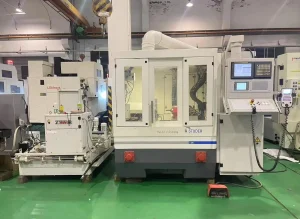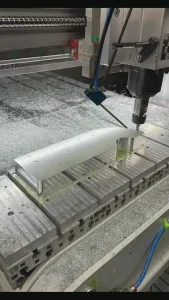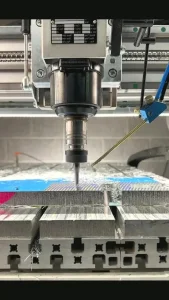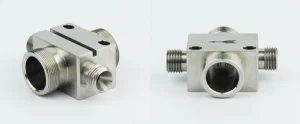The cost of parts processing is affected by many factors, from material selection to post-processing and testing. Differences in each step can lead to significant cost fluctuations. The following will be a detailed analysis of core dimensions such as material properties, processing technology, precision requirements, and production scale:
1. Material Cost: The Core Variable in Basic Cost
Materials are the basis of processing. Their types, specifications, and performance directly determine the lower limit of costs:
Material Types:
Common metals (such as 45# steel and aluminum alloy 6061) have relatively low costs (approximately 10-50 yuan/kg);
Specialty alloys (titanium alloy TC4 and high-temperature alloy Inconel 718) have significantly higher costs (approximately 200-500 yuan/kg for titanium alloys and over 1,000 yuan/kg for high-temperature alloys) due to their difficulty in smelting and excellent mechanical properties (suitable for high-end applications such as aerospace);
Non-metallic materials (engineering plastic PEEK and ceramic zirconia) have significantly different costs (PEEK is approximately 500-1,000 yuan/kg, while ceramics can cost up to 2,000 yuan/kg due to the difficulty of molding). Material Specifications:
Custom-sized materials (such as extra-thick plates and ultra-thin bars) are 30%-50% more expensive than standard sizes due to the need for specialized rolling or cutting.
Allowance Requirements: Precision machining requires a machining allowance (typically 5%-10%). The larger the allowance, the lower the material utilization rate and the higher the cost (for example, if a 100mm long bar is machined to 80mm, 20% of the material will be wasted).
Material Pretreatment:
Required heat treatment (quenching, annealing) and surface coating (chrome plating, gold plating) will increase costs (e.g., quenching costs approximately 50-100 yuan per piece, and gold plating is charged by area, approximately 200-500 yuan per square meter).
2. Process Complexity: The Main Source of Cost Variation
The more process steps and the higher the difficulty, the higher the cost.
Number of Processes:
Simple parts (such as optical shafts) may require only 2-3 steps of turning and grinding.
Complex parts (such as curved surfaces processed through five-axis machining) require 5-10 steps, including rough milling, semi-finishing milling, finishing milling, EDM, and polishing. Each additional step increases costs by 10%-30% (including equipment depreciation, labor, and auxiliary materials).
Equipment Type:
General CNC lathes/milling machines (accuracy ±0.01mm) cost approximately 50-100 RMB/hour.
High-precision five-axis machining centers (accuracy ±0.001mm) cost 200-500 RMB/hour due to their high purchase cost (millions per unit) and high maintenance costs.

Specialized machining equipment (EDM, laser machining) is even more expensive (300-800 RMB/hour) due to its lower efficiency (for example, EDM machining speeds are only 0.1-1 mm³/min).
Tools and Accessories:
Ordinary carbide tools (for machining steel) are low-cost (a few dozen yuan per tool), but have a short lifespan (needing replacement after machining approximately 100-500 parts).
Superhard tools (diamond PCD, cubic boron nitride CBN) are suitable for machining high-hardness materials (such as ceramics and hardened steel). They cost hundreds to thousands of yuan per tool, but they can reduce tool change frequency and indirectly control costs.
Cutting fluids, abrasive pastes, and other accessories (such as diamond abrasive paste for high-precision grinding, which costs approximately 500-1000 yuan per kg) are also included in the cost.
3.Precision and Quality Requirements:
Cost Amplifiers:
The higher the dimensional tolerances, form and position tolerances, and surface quality requirements for precision parts, the more exponentially the cost increases:
Dimensional Tolerances:
Parts with tolerances of ±0.01mm can be processed using standard CNC equipment at a relatively low cost.
Tolerances of ±0.001mm (micrometer level) require ultra-precision equipment (such as jig grinders) and require multiple measurements and adjustments, increasing processing time by 3-5 times and costs by 200%-500%.
Ultra-precision parts (tolerances ≤ ±0.0005mm) require a constant temperature and humidity environment (increasing workshop construction costs by over 50%) and have a high scrap rate (up to 20%-30%), further driving up costs.
Surface Quality:
Surface roughness of Ra1.6μm (general precision) can be achieved through conventional grinding;
Ra0.02μm (mirror-grade) requires ultra-fine polishing (such as magnetorheological polishing), which increases processing time and costs by 10-20 volte.
If defects such as scratches and pores are required, 100% microscopic inspection is required, increasing inspection costs by 50%-100%.
Geometric Tolerances:
Parallelism and perpendicularity requirements of ≤0.005mm/m require specialized fixtures and multiple adjustments, reducing processing efficiency by over 50% and increasing costs accordingly.
4.Production Scale and Batch:
Cost Adjustment Lever Batch Size:
Small batches (1-10 pieces): Require individual programming and fixture commissioning, resulting in high amortized setup costs (e.g., programming fees of 500-2000 yuan/time), and the cost per piece can be 5-10 times that of large batches.
Large batches (1000 pieces or more): Process optimization (e.g., dedicated tooling, automated loading and unloading) can reduce the amortized cost per piece by 30%-60%, and material purchases can enjoy bulk discounts (reducing by 5%-15%).
Production Cycle:
Expedited orders (e.g., delivery within 3 days) are prioritized, potentially disrupting the original production schedule. Expedited fees are typically 50%-100% of the normal cost.
Regular cycle times (1-2 weeks) allow for more manageable production schedules.
5. Design Complexity and Manufacturability:
Key to Hidden Costs whether a part design adheres to the “Design for Manufacturability (DFM)” principle directly impacts manufacturing difficulty and cost:
Structural Complexity:
Deep holes (aspect ratio > 10), narrow slots (width < 0.5mm), and undercut structures require special tooling or processes (such as electro-spark drilling), increasing costs by 50%-200%.
Parts with symmetrical structures and standardized interfaces are easier to process, reducing costs by 20%-30%.
Benchmarks and Positioning:
If positioning datums are not clearly defined in the design, multiple alignments will be required during manufacturing, increasing processing time by over 30%.
Complex parts require custom fixtures (costing 500-5000 yuan/set), which contribute significantly to fixture costs in small-batch production.
6.Testing and Quality Control: Necessary Costs Precision parts require rigorous testing.
The more testing items and the higher the precision requirements, the higher the cost:
Testing Equipment:
Routine testing (calipers, micrometers) is low-cost (almost negligible);
High-precision testing (coordinate measuring machines, roundness gauges) is billed by time (approximately 100-300 yuan/hour), with complex parts requiring 1-2 hours per part;
Specialized testing (such as non-destructive testing and material composition analysis) is more expensive (ranging from hundreds to thousands of yuan per test).
Quality Traceability:
In the aerospace and medical sectors, full-process quality reports (such as material certification and process inspection records) are required, increasing documentation and management costs by 10%-20%.

7.Other Factors: Indirect Costs
Labor Costs: Hourly wages for skilled workers (such as five-axis operators and precision grinders) are 50%-100% higher than for regular workers (approximately 50-100 RMB/hour).
Equipment Depreciation: High-precision equipment (such as five-axis machining centers) depreciates over approximately 10 years, with an average annual depreciation of hundreds of thousands of RMB, representing 5%-15% of the cost of each product.
Administrative Costs: Administrative costs (such as production planning and material management) for small-batch, high-variety production are 20%-30% higher than for large-volume production.






